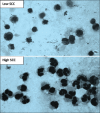Milk somatic cells, factors influencing their release, future prospects, and practical utility in dairy animals: An overview
- PMID: 29915493
- PMCID: PMC5993762
- DOI: 10.14202/vetworld.2018.562-577
Milk somatic cells, factors influencing their release, future prospects, and practical utility in dairy animals: An overview
Abstract
Milk somatic cells (SCs) are a mixture of milk-producing cells and immune cells. These cells are secreted in milk during the normal course of milking and are used as an index for estimating mammary health and milk quality of dairy animals worldwide. Milk SC is influenced by cow productivity, health, parity, lactation stage, and breed of an animal. Any change in environmental conditions, poor management practices, and also stressful conditions significantly increases the amount of SC coming in milk. Better hygiene and proper nutrition help in reducing milk SC. Milk with low SC means better milk products with a longer shelf life. The present review describes the role of SCs (both secretory and immune) in milk, their role in maintaining the integrity of the mammary gland, and factors affecting their release in milk. This information may help to reduce milk somatic cell counts (SCCs) and to establish differential SCC standards.
Keywords: dairy animals; factors influencing; milk; somatic cells release; utility.
Figures





References
-
- Sharma N, Singh N.K, Bhadwal M.S. Relationship of somatic cell count and mastitis:An overview. Asian Aust. J. Anim. Sci. 2011;24:429–438.
-
- Rainard P, Riollet C. Innate immunity of the bovine mammary gland. Vet. Res. 2006;37:369–400. - PubMed
-
- Boutinaud M, Jammes H. Potential uses of milk epithelial cells:A review. Reprod. Nutr. Dev. 2002;42:133–147. - PubMed
-
- Hillerton J.E. Redefining mastitis based on somatic cell count. IDF. Bull. 1999;345:4–6.
Publication types
LinkOut - more resources
Full Text Sources
Other Literature Sources
Research Materials
